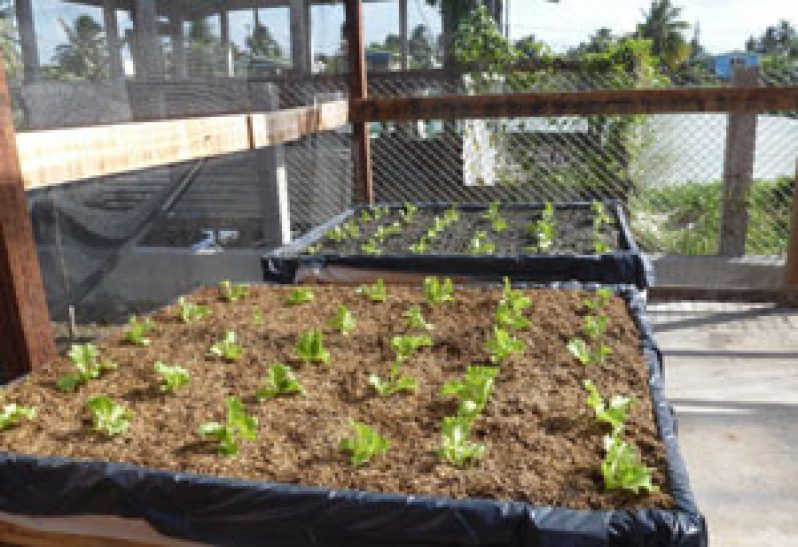A SUBSTRATE is the material in which the root system of the plant will develop. It can be solid (in which case it serves to anchor the plant) or liquid, in which case it maintains an appropriate balance of air and the nutrient solution.
 The important factors in selecting a substrate are: Its availability; the proximity to the source; and the cost. Some common substrates used in the tropical regions are: Sand, rice hulls (paddy shells), grounded clay bricks, coconut fibre dust, charcoal dust, sawdust, grounded volcanic stones and water.
The important factors in selecting a substrate are: Its availability; the proximity to the source; and the cost. Some common substrates used in the tropical regions are: Sand, rice hulls (paddy shells), grounded clay bricks, coconut fibre dust, charcoal dust, sawdust, grounded volcanic stones and water.
A good substrate must: Be capable of maintaining moisture and draining excess water; not degrade or decompose easily; not contain nutritive mineral elements, microorganisms harmful to Man or plants; not be contaminated with industrial residual waste.
Recommended substrate mixtures for hydroponic gardening include: 50 % rice hull: 50 % ground volcanic stones; 60 % rice hull: 40 % sand; 60 % rice hull: 40 % ground clay bricks; 80 % rice hull; and 20 % saw dust.
In Guyana, where rice hulls are most commonly used, you can use a ratio of two buckets of rice hulls to one bucket of sand (2:1).
The minerals that the plant needs are dissolved into the water, which is then watered directly to the plants. So, instead of the plants searching throughout the soil for their minerals, they draw them directly from the water that they are being fed.
Production System A Hydroponic Production System can be classified as “Open” or “Closed”.
A Hydroponic Production System can be classified as “Open” or “Closed”.
In the ‘open’ system, the nutrient solution is mixed and applied by hand, with a container, to the plant as required. This is the more common system in Guyana.
In the ‘closed’ system, the nutrient solution is re-circulated continuously, by providing the nutrients that the plant requires in the water, and by manually shaking up the water on a daily basis.
In the ‘open’ system, lettuce, pakchoy, celery and other seedlings are transplanted into a sand/paddy husk substrate. The time from transplanting to harvesting depends on the vegetable species. However, as an example, you can harvest lettuce and pakchoy at about 28-42 days after transplanting, and celery about 40-56 days after transplanting.
Fertilizers and application
Hydroponic fertilizers contain a balanced amount of nutrients to produce healthy and productive plants. In general, the nutrients required by the plants are best grouped as ‘major nutrients’ and ‘minor nutrients’.
This production system revolves around the preparation and use of three concentrated solutions made from combinations of major and minor nutrients. The concentrated solutions are prepared for you by your Field Support Team.
Three solutions (A, B and C) which represent a mixture of major and minor nutrients are prepared from a range of solid materials. The solution to be applied to the plants is prepared according to the following guidelines:
Get an empty 1 litre bottle;
• Add about 500ml of clean water (half full the bottle);
• Add 5 ml of Solution A and mix thoroughly by shaking vigorously;
• Add 2.5 ml of Solution B and mix thoroughly by shaking vigorously;
• Add 5 ml of Solution C and mix thoroughly by shaking vigorously;
• Add more clean water to bring the total amount of solution to 1 Liter
Apply 50 – 100 ml of the diluted fertilizer solution per plant per day (in early stages of the plant, 50ml are applied, as the plant advances in growth, the amount applied is increased).
For fruit-bearing vegetables such as tomato and pepper, more than 100ml per plant per day will be required. For more information, speak to your Hydroponics Extension Officer.
Apply fertilizer six days a week, in the morning (at about the same time each day). Apply water alone in the afternoon, liberally (soak to satisfaction).
On the 7th day, apply only water to the plants, morning and afternoon.
Next Week: Pest Management and control.
(Article courtesy of HOME-BASED HYDROPONICS VEGETABLE PRODUCTION MANUAL By Kelvin Craig, Franklyn Harvey, Shaun Francis, Gavin Gounga, Panday Mansaram Sigmund McKenzie, Ryan Nedd. Partners of the Americas (Partners) / Caribbean Self-Reliance International (CASRI)




.jpg)










